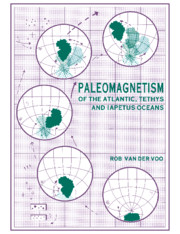Book contents
- Frontmatter
- Contents
- Preface and acknowledgements
- 1 Prologue
- 2 Paleopoles and paleomagnetic directions
- 3 Megaplates, microplates, blocks, terranes, accreted slivers, thrusts and olistostromes
- 4 Paleomagnetic information – what makes a paleopole valuable?
- 5 The major continents and Pangea
- 6 The opening of the Atlantic Ocean
- 7 The Tethys blocks
- 8 The terranes, blocks and adjacent continents of the Iapetus Ocean
- 9 Epilogue
- 10 Appendix
- References
- Index
9 - Epilogue
Published online by Cambridge University Press: 24 November 2009
- Frontmatter
- Contents
- Preface and acknowledgements
- 1 Prologue
- 2 Paleopoles and paleomagnetic directions
- 3 Megaplates, microplates, blocks, terranes, accreted slivers, thrusts and olistostromes
- 4 Paleomagnetic information – what makes a paleopole valuable?
- 5 The major continents and Pangea
- 6 The opening of the Atlantic Ocean
- 7 The Tethys blocks
- 8 The terranes, blocks and adjacent continents of the Iapetus Ocean
- 9 Epilogue
- 10 Appendix
- References
- Index
Summary
At this time of writing, it is July 1991, my sabbatical is nearly over, Barcelona is filling up with tourists, and suddenly I am suffering from a bit of writer's block. What does one put into a concluding chapter of a book like this, I wonder, when most sections of the preceding four chapters were already syntheses by themselves? How does one reach a conclusion on the basis of a few hundred pages of ‘conclusions’?
Clearly, it is necessary to reflect back on the goals of the book as outlined in the first chapter – but these goals were reader-oriented and I am at a loss to predict what the average reader will feel when she or he has arrived at this point: disgust, puzzlement, delight, frustration, a modicum of appreciation, or just a severe case of snake-bite poisoning?
A few colleagues of fame who are experts in paleomagnetic analysis have volunteered their critiques and praise of some or all of the preceding chapters, pleasingly more praise than criticisms. However, this book, I recall, was not only written for the expert; my intent was to guide the tectonician, the structural geologist or the biogeographer through the maze of the extensive paleomagnetic data base and to help them recognize, if not appreciate fully, the forest more than the shrubs and trees.
What then have we learned? I would venture, foremost, that we have learned that the paleomagnetic data are overwhelmingly in support of a mobilistic Earth perspective; no matter whether the process is called the drift of the major continents (Chapter 5), plate tectonics (neo- and paleo- as in Chapters 6 and 8, respectively), microplates or displaced terranes (Chapters 7 and 8), the surface of the Earth is seen to consist of continental and oceanic elements that are, and have been, in constant relative motion.
- Type
- Chapter
- Information
- Paleomagnetism of the Atlantic, Tethys and Iapetus Oceans , pp. 267 - 274Publisher: Cambridge University PressPrint publication year: 1993



